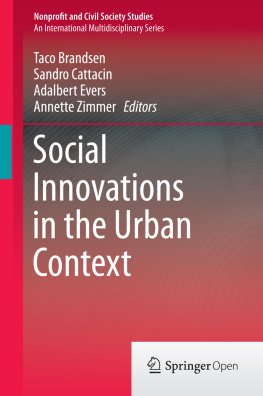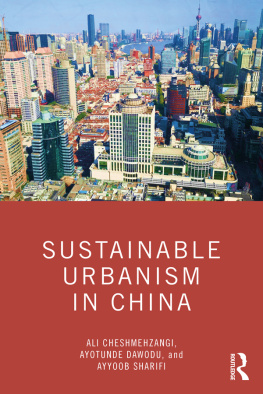1.1 The Promise and Challenge of Social Innovations
The effort to strengthen social cohesion and lower social inequalities is among Europes main policy challenges. At the urban level, these great challenges become visible and tangible, which in many senses makes cities a microcosm of society. It means that local welfare systems are at the forefront of the struggle to address this challengeand they are far from winning. While the statistics show some positive signs, the overall picture still shows sharp and sometimes rising inequalities, a loss of social cohesion and failing policies of integration and inclusion. When we focus on specific groups in society (e.g. migrants), the situation is even more dire. It is clear that new ideas and approaches to tackle these very wicked problems are needed.
Contrary to what is sometimes thought, a lack of bottom-up innovation is not the issue in itself. European cities are teeming with new ideas, initiated by citizens, professionals and policymakers. There are by now many examples of innovation, paraded by think tanks and policymakers as tomorrows answers. This is certainly promising. Yet this altogether too rosy picture obscures some of the drawbacks, which are both practical and academic in nature. In public policy, there has often been the suggestion that such innovations will substitute for, rather than complement, present welfare arrangements. This has made the concept rather suspicious, in the eyes of many. It is not our wish to enter into a political debate here, but it must be observed that we as yet know little about the broader effects of innovations and how these compare to the effects of established programmes. Also, it is often implicitly suggested that social innovation is necessarily good, which is again unproven. As we will show in this book, while it is fine to regard social innovation with sympathetic eyes, it is misleading to ignore the contested and dark sides of the phenomenon.
Academically, there are also various reasons to be careful with the term. To begin with, the concept of social innovation is poorly defined and demarcated. Furthermore, innovations are too often presented as pearls without an oyster: They are pretty to look at, but we do not know where they come from. How do such innovations originate in a specific local context of social relations, regulations, space and politics? What exactly did they contribute to local welfare systems? And how can we ensure a positive interaction between these forms of social innovation and public policies for reform? The European Union (EU)-funded international research project Welfare Innovations at the Local Level in Favour of Cohesion (WILCO) was set up to find out specifically how social innovations can help to deal with the challenge of social inclusion , in the context of established local welfare systems.
This entails a special perspective on the phenomenon of social innovation and the various promoters, agents of change and social entrepreneurs that are involved with them. The new approaches and instruments developed, which are part of social innovations , should, self-evidently, work in the here and now, in the place they are operating; but they also contain messages concerning values, hopes and assumptions. Other actors, such as the political-administrative system can then engage with and react to innovations in various ways. They can borrow successful instruments, adapting them to their own administrative and policy frameworks. But equally, these other actors may also feel challenged by the nature of these new instruments or by the innovators themselves. There is, then, a significant difference, as well as significant room for variation, between making use of innovations, their methods and instruments and actually learning from them. From that point of view, our analysis of innovation aims to facilitate a broader concept of policy learning that goes beyond making (greater) use of social innovations. It tries to understand them as socially embedded phenomena, with all the strings attached.
1.2 Social Innovation: A Contested Issue and the Concept Proposed by WILCO
The definition of social innovations is a bone of contention. In their overview written for the European Commission and the WILCO project, Jenson and Harrison have referred to social innovation as a quasi-concept, a hybrid, making use of empirical analysis and thereby benefitting from the legitimising aura of the scientific method, but simultaneously characterised by an indeterminate quality that makes it adaptable to a variety of situations and flexible enough to follow the twists and turns of policy, that everyday politics sometimes make necessary (European Commission , p. 16). Indeed, it has achieved the status of a buzzword in national and European policy circles. US President Obama established no less than two offices for social innovation. The EU has used the term to fund several initiatives, including the research project upon which this book is based. It is then little wonder that the meaning has diluted, sometimes referring to anything that is considered new and that is not technical.
Although as an academic concept, it is less wide-ranging, there still remains a broad range of interpretations. Some posit simply that it must constitute a new approach to a particular kind of problem. The Stanford Centre for Social Innovation, for example, describes it as the process of inventing, securing support for, and implementing novel solutions to social needs and problems (Phillis et al. ). This implies not only that an innovation must be radical (transformative), but also that it changes the power structure within the system where it is introduced. The problem with this kind of definition is less with its normative character, but with its essentialist nature. It is true that innovations are about new ideas and purposes deriving from established paths and patterns getting practical; however, it must be likewise considered that they are about processes and ways of development under conditions and in contexts where interaction is not determined and foreseeable ex ante. Innovatory effects of a new product, strategy or service can be path breaking to different degrees. Thinking this way it becomes clear that what is needed is a concept of social innovation as a complex societal process, rather than a mere classificatory definition of an action or product.
For the purposes of the WILCO project, we defined social innovation as both products and processes; ideas translated into practical approaches; new in the context where they appear. It was important for us to use such a definition, rather than a more specific one, because one cannot clearly predict what comes out of even a very promising innovation in the course of its development. The problem with defining social innovation resides less in innovation and much more in the meaning one attributes to social. Studying the current literature on conceptualising and defining social innovations, one finds that social is mainly equated with improvement (Phillis ), and a range of other good things.











